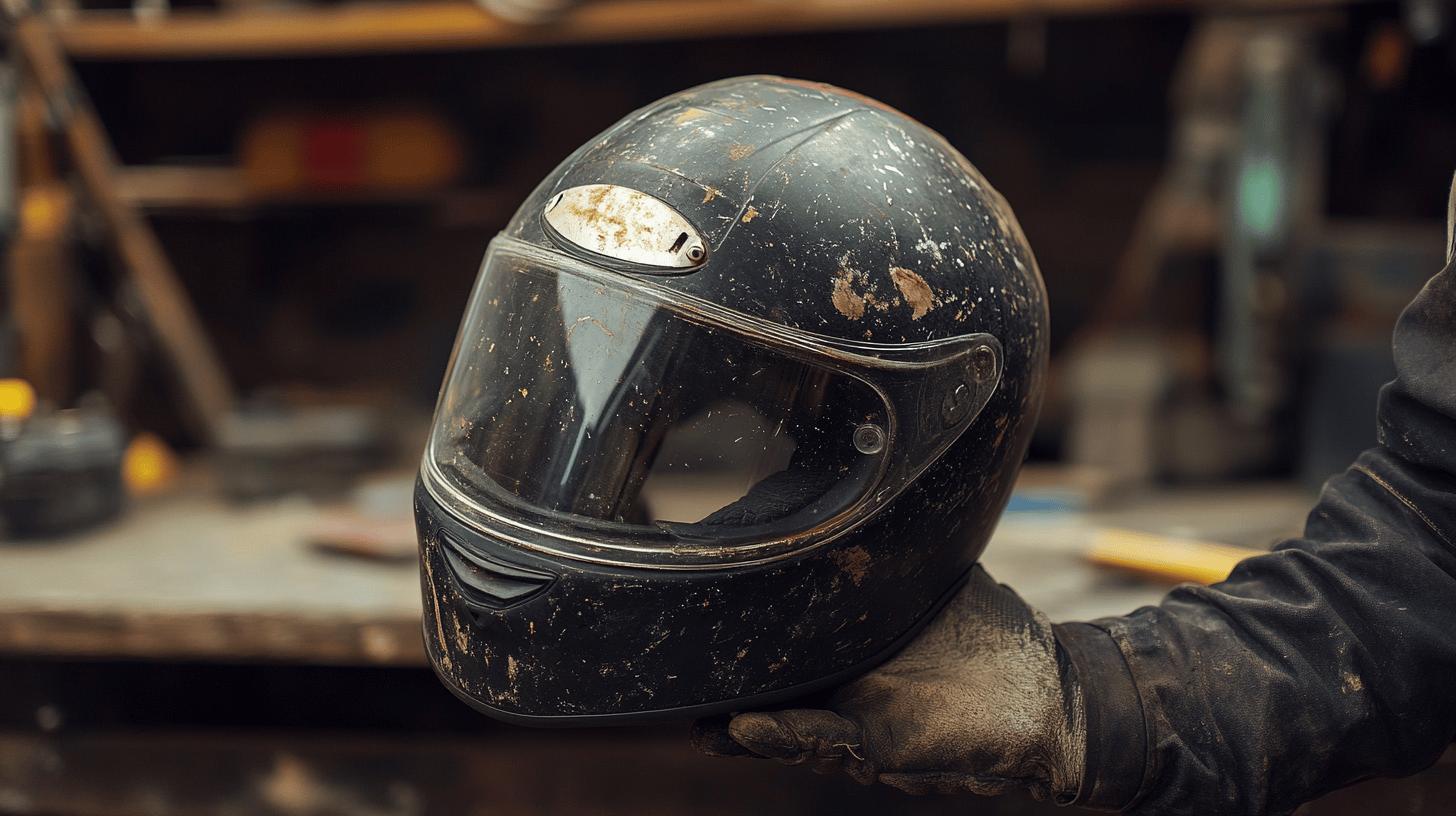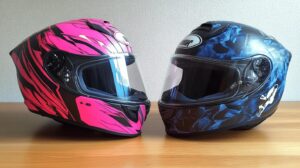When it comes to racing and road safety, choosing the right helmet is as crucial as selecting a suitable vehicle. But how different are motorcycle helmets from drag racing helmets?
These helmets are designed to meet the distinct demands of their respective environments. Motorcycle helmets focus on mobility and visibility, equipped with large visors and ventilation systems for a comfortable ride.
In contrast, drag racing helmets prioritize protection against fire hazards, featuring materials like Nomex. Understanding these differences not only ensures optimal performance but also enhances safety on the track or the road.
Design and Material Differences: Motorcycle vs Drag Racing Helmets

Motorcycle helmets are crafted with a keen emphasis on visibility and mobility, catering to the dynamic conditions of road riding. They typically feature large visors and multiple ventilation ports to enhance the rider’s field of view and airflow, crucial for maintaining comfort and awareness on the road.
In contrast, drag racing helmets are designed for the controlled environment of a race track, where fire retardancy and communication system integration are paramount. These helmets often have smaller visors and fewer ventilation ports to prioritize structural integrity and safety features.
Motorcycle helmets utilize advanced synthetic materials such as polycarbonate or fiberglass composites. These materials strike a balance between weight and durability, providing protection against direct impacts and abrasions from potential slides on pavement.
On the other hand, drag racing helmets incorporate materials like carbon fiber and Kevlar, known for their high strength-to-weight ratios. A defining feature of drag racing helmets is the use of Nomex, a fire-retardant material, which offers critical protection in the event of a fire.
This fire resistance is vital given the potential for drivers to be trapped in burning vehicles, where rapid heat exposure can occur.
| Helmet Type | Materials | Design Purpose |
|---|---|---|
| Motorcycle Helmet | Polycarbonate, Fiberglass Composites | Visibility, Mobility, Abrasion Resistance |
| Drag Racing Helmet | Carbon Fiber, Kevlar, Nomex | Fire Retardancy, Impact Protection, Communication System Integration |
Safety Features and Standards: What Sets Helmets Apart

Safety standards are crucial in distinguishing motorcycle helmets from drag racing helmets. Motorcycle helmets are often designed to meet DOT (Department of Transportation) standards, which emphasize protection against impacts and abrasion, common in road crashes. Drag racing helmets, meanwhile, adhere to Snell standards, which incorporate additional safety measures like fire resistance and head restraint compatibility.
Motorcycle helmets are engineered to absorb and deflect the varied forces encountered during a road accident, including direct impacts and prolonged abrasion from sliding. Features such as multi-density EPS (Expanded Polystyrene) liners are common, providing a cushion against blunt force.
Drag racing helmets, however, prioritize fire retardancy, a critical feature given the potential for vehicle fires on the track. They often include materials like Nomex for flame resistance and are designed to accommodate the Hans Device, a head and neck support system that mitigates injury during high-speed collisions.
Regulatory requirements for motorcycle helmets typically involve DOT certification in the United States, ensuring they meet minimum safety standards for impact resistance and penetration protection. In contrast, drag racing helmets often require Snell certification, which includes stringent testing for fire resistance and structural integrity. ECE (Economic Commission for Europe) certification may also apply, offering an international standard for safety.
In real-world scenarios, these safety standards are vital for ensuring maximum protection. Motorcycle helmets must withstand diverse environmental conditions and potential crashes, prioritizing visibility and mobility.
Drag racing helmets, designed for the controlled, high-risk environment of the track, focus on minimizing injury through enhanced fire protection and head restraint integration. Understanding these distinctions helps users select the appropriate helmet for their specific needs, maximizing both safety and performance in their respective environments.
Aerodynamics and Comfort: Helmet Features for Optimal Performance

How do the aerodynamic designs of motorcycle and drag racing helmets differ? Motorcycle helmets are crafted to handle dynamic environmental changes, emphasizing streamlined shapes to reduce wind resistance during high-speed rides.
These helmets often feature elongated rear spoilers and rounded shells to help stabilize the rider's head amidst turbulent airflows commonly encountered on open roads. In contrast, drag racing helmets are engineered for stability at extreme speeds on racetracks.
They prioritize minimizing lift and drag, with more compact profiles and specific vent placements to maintain helmet stability and improve driver comfort during intense races.
What comfort features are integrated into these helmets? Motorcycle helmets are equipped with multiple ventilation ports to enhance airflow and regulate temperature, a crucial factor for long hours on the road.
Their interiors often boast moisture-wicking liners that keep the rider cool and comfortable by reducing sweat buildup. Drag racing helmets, however, focus on noise reduction and thermal management, incorporating advanced padding and strategically placed vents to mitigate heat without compromising aerodynamic efficiency.
This design helps maintain concentration by counteracting the distracting noises and high temperatures experienced in a racing cockpit.
Key comfort and aerodynamic features of motorcycle and drag racing helmets include:
-
Streamlined shapes for reducing wind resistance (motorcycle)
-
Elongated rear spoilers for stability in turbulent conditions (motorcycle)
-
Multiple ventilation ports for temperature regulation (motorcycle)
-
Compact profiles to minimize lift at high speeds (drag racing)
-
Advanced padding for noise reduction and thermal management (drag racing)
Helmet Usage Contexts: When to Choose Which Type

Motorcycle helmets excel in road safety scenarios. Designed for visibility and mobility, they are the protective gear of choice for daily commutes, long-distance touring, and urban riding. Their construction focuses on providing a broad field of view and allowing for the rider's head movements, essential for navigating traffic and maintaining situational awareness.
Drag racing helmets, on the other hand, are specifically crafted for competitive racing on tracks. These track helmets prioritize fire resistance and integration with head restraint systems, such as the Hans Device. Ideal for drag strips and other high-speed racing environments, these helmets are engineered to protect against the unique hazards of racing, including high-impact collisions and potential fires.
When selecting the appropriate helmet for your needs, consider the following points:
-
Motorcycle helmets are best for road scenarios requiring frequent head movement.
-
Drag racing helmets offer enhanced protection for high-speed track environments.
-
Visibility and airflow are key features of motorcycle helmets.
-
Fire resistance and head restraint compatibility are crucial in drag racing helmets.
-
Choose based on the specific demands of your riding or racing environment.
Helmet Maintenance and Replacement: Keeping Your Gear Safe

Regular maintenance of helmets is critical for ensuring their protective capabilities remain intact. Over time, exposure to environmental factors and regular use can degrade materials, reducing the effectiveness of both motorcycle and drag racing helmets. Consistent care helps preserve their integrity and performance, safeguarding riders and drivers alike.
Motorcycle helmets typically feature removable liners, allowing for straightforward cleaning and maintenance. It's important to wash these liners periodically with mild detergents to remove sweat and dirt, prolonging the helmet’s lifespan. For drag racing helmets, maintenance demands are more specialized.
These helmets often incorporate fire-retardant materials such as Nomex, which require gentle cleaning methods to maintain their fire-resistant properties. Avoid harsh chemicals and always follow manufacturer guidelines to ensure these critical features remain effective.
-
Inspect regularly for any signs of wear, cracks, or damage.
-
Clean liners as needed, ensuring they are fresh and free from odors.
-
Avoid exposure to extreme temperatures or direct sunlight for prolonged periods.
-
Replace helmets after any significant impact, even if no visible damage is present.
-
Follow manufacturer recommendations for periodic replacement, usually every 3-5 years, to keep up with advancements in safety standards and materials.
Final Words
Exploring the nuances of motorcycle vs drag racing helmets: what's the difference, reveals distinctions in design, materials, and safety features. Motorcycle helmets focus on visibility and mobility, whereas drag racing helmets emphasize fire resistance and communication systems.
Understanding these distinctions helps riders select the right helmet for their specific needs and environments. With proper maintenance and knowledge of standards, riders can ensure their helmets remain safe and effective. Embrace the riding journey with confidence and enjoy the ride responsibly.
FAQ
Are motorcycle and racing helmets the same?
Motorcycle and racing helmets differ in design and purpose. Motorcycle helmets focus on visibility and mobility, while racing helmets prioritize fire resistance and communication integration for use in high-speed environments.
Can I use a motorcycle helmet for racing?
Using a motorcycle helmet for racing is not advisable. Racing helmets meet specific safety standards for fire retardancy and may include head restraint systems unsuitable for motorcycle helmets.
What kind of helmet is needed for drag racing?
For drag racing, helmets should comply with Snell or similar certifications, focusing on fire resistance and head restraint integration. The helmet must also provide protection at high speeds.
What is the difference between an F1 helmet and a MotoGP helmet?
F1 helmets prioritize fire resistance and aerodynamics, crafted for high-speed car racing. MotoGP helmets emphasize visibility and comfort for motorcycle racing, with features like larger visors and additional ventilation.
Can I use a car helmet on a motorcycle?
Car helmets are unsuitable for motorcycle use due to their design differences. Motorcycle helmets emphasize increased visors and ventilation for improved visibility and comfort, unlike car helmets designed for vehicle interior protection.
Is a motorcycle helmet suitable for a car track day?
Motorcycle helmets can lack the necessary fire resistance features mandated for car track days. Car racing helmets often include integrated communication and fire retardant materials like Nomex, which are not present in motorcycle helmets.

Brad Mitchell is a seasoned motorcycle enthusiast with over 16 years of riding experience. He’s spent countless hours on the open road, particularly favoring scenic routes aboard his trusted Harley-Davidson. Brad’s laid-back approach to life and riding gives him a unique perspective on motorcycle gear and safety, which he shares through his in-depth reviews and expert advice on ProtectiveGearz.



